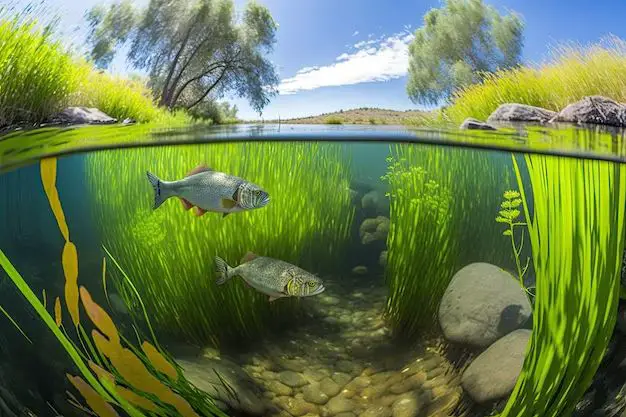When it comes to building an above ground pond, one of the most important considerations is determining the proper depth. The depth of the pond plays a critical role in maintaining good water quality and providing a healthy environment for fish and plants. In this article, we will explore the factors that determine ideal pond depth and provide recommendations for above ground pond depths.
Page Contents
Why pond depth matters
The depth of an above ground pond affects several aspects of the pond environment:
- Water temperature – Deeper ponds are better insulated from temperature fluctuations. Shallow ponds are more prone to freezing in winter and overheating in summer.
- Dissolved oxygen – Deep areas provide cooler water that can hold more dissolved oxygen for fish.
- Light penetration – Most pond plants need about 1-3 feet of depth for good growth. Deeper water prevents sunlight from reaching the bottom.
- Gas exchange – Surface gas exchange is important for replenishing oxygen. A deeper pond has less surface area relative to its volume.
- Stratification – During summer, shallow ponds tend to mix while deeper ponds may stratify into distinct temperature layers.
- Wind and wave action – Shallow water is more impacted by waves that can resuspend sediment.
Finding the right balance between depth and surface area is key for an ecologically thriving above ground pond.
Recommended minimum depth
Most experts recommend a minimum water depth of 18-24 inches in at least part of the pond. Here are some of the reasons why:
- Prevents complete freezing – In most regions, ponds less than 18 inches deep may freeze solid in winter. This is dangerous for fish and plant life.
- Oxygenation – Water that is 24 inches deep allows for some circulation of oxygenated surface water.
- Plant growth – 18-24 inches provides a suitable depth for most marginal and floating pond plants to grow.
- Fish overwintering – Koi and goldfish need deep areas of at least 18-24 inches to survive freezing winters in above ground ponds.
Any shallower than 18 inches risks freezing, overheating, and stagnation. A minimum depth of 24 inches is a good guideline for general pond health and function.
Recommended maximum depth
Is there such a thing as too deep for an above ground pond? Generally, a maximum depth of 2-3 feet is recommended. Reasons for limiting the deepest areas include:
- Plant growth – Most aquatic plants need shallow water and will not thrive beyond 3 feet depth.
- Gas exchange – Deeper water reduces the surface area to volume ratio, limiting oxygen replenishment.
- Stratification – Above ground ponds may stratify in summer if deeper than 3 feet, preventing circulation.
- Light penetration – Water below 3 feet will be too dark for plant growth and algae may take over.
- Fish overwintering – Most fish do not require depths greater than 2-3 feet to overwinter successfully.
For these reasons, it is generally not recommended to have areas exceeding 3 feet depth in small backyard ponds. Deep ends beyond 3 feet can create an imbalance in the pond environment.
Recommended pond depth for fish
If planning to keep fish, aim for these pond depths:
- 18-24 inches minimum over 25% of pond
- Include a 2-3 foot deep end for fish to overwinter
- Slope sides to 2-3 feet maximum depth
- Make sure fish have shallow areas for feeding and resting
This range of depths provides fish with adequate oxygenated water, wintering habitat, and foraging areas. Having a deeper end gives fish cooler water to retreat to during hot summer temperatures.
Pond depth for koi and goldfish
Koi and goldfish specifically need:
- Minimum 24-30 inches depth over 25% of pond
- Deep end of 2.5-3 feet for overwintering
These large fish are vulnerable to predators like raccoons and herons, so deeper areas allow them to hide. Give them ample deep water while also providing shallow sections along the edges for resting and grazing.
Pond depth zones
The ideal above ground pond design incorporates different depth zones, each with a purpose:
- Shallow shelves: 6-18 inches deep for marginal plants
- Intermediate depth: 18-24 inches for aquatic plants
- Open water: 18-36 inches for circulation and fish
- Deep end: 24-36 inches for fish refuge
Incorporating shelves, sloping sides, and a deep end creates diverse aquatic habitats and stable water quality. The pond bottom can be terraced or gradually sloped from shallow to deep areas.
Calculating average depth
Determining the average depth of your pond design is useful for estimating water volume. Calculate average depth as follows:
- Calculate the pond’s surface area by measuring length x width.
- Find the volume by multiplying surface area x depth at each level.
- Add all the partial volumes together.
- Divide total volume by the surface area.
For example, a pond with a 300 sq ft surface area, two 2-foot deep shelves of 100 sq ft each, and a 3-foot deep center of 100 sq ft would have an average depth of 2.5 feet.
Design considerations for depth
Some other tips for integrating depth into your pond design:
- Slope the edges very gradually to prevent steep drop-offs.
- Add rocks, ledges, or shelves to create depth variation.
- Place deeper areas near filtration equipment for efficient circulation.
- Orient the deep end away from prevailing winds to limit mixing.
- Design different zones based on priorities like plants, fish, wildlife.
Conclusion
An above ground pond should have varying depths for optimal health, function, and aesthetics.Aim for a minimum of 18-24 inches in at least a quarter of the pond for plants and fish. Incorporate shelves, gradually sloping sides, and a 2-3 foot deep end. Consider the needs of plants, fish, and other wildlife when designing depth zones. Following these guidelines for an average depth of around 2-3 feet will lead to a thriving pond ecosystem that balances aquatic life with water quality.
